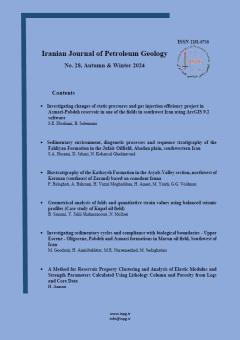روشی جهت خوشه بندی خصوصیات مخزن و بررسی مدول های الاستیک و پارامترهای مقاومتی محاسبه شده با ستون سنگ شناسی و مقدار تخلخل حاصل از لاگ و مغزه
الموضوعات : Petroleum Geology
1 - دانشگاه صنعتی سهند تبریز، دانشکده مهندسی نفت، فارغ از تحصیل کارشناسی ارشد مهندسی نفت
الکلمات المفتاحية: گروه بندی مخزن, خوشه بندی چند تفکیکی بر پایه گراف, پارامترهای الاستیسیته و مقاومتی,
ملخص المقالة :
تعیین گونههای سنگی و محاسبه پارامترهای الاستیسیته و مقاومتی سازند از اصلیترین و پیچیدهترین پارامترهای پتروفیزیکی- ژئومکانیکی مخازن هیدروکربوری بوده که محاسبه دقیق آنها مبنای بسیاری از مطالعات مهندسی نفت و ژئومکانیک مخزن است. به این منظور در پژوهش حاضر در مرحله اول تعداد بهينه الكتروفاسيسها با روش خوشهسازي چند تفکیکی بر پايه گراف(MRGC[1])، براي چاه مورد مطالعه از ترکیب اطلاعات زمینشناسی، نمودارهای معمول و مصنوعی(NDS[2] و [3]VDL) بدست آمد. الگوریتم معرفی شده شامل اعمال اثر لیتولوژی(سنگشناسی) و نوع تخلخل در محاسبات جهت گروه بندی دقیق مخزن است. در این مرحله تعداد 5 کلاس و گروه بهينه الكتروفاسيسها با روش خوشهسازي چند تفکیکی بر پايه گراف(MRGC)، براي چاه مورد مطالعه بدست آمد. در مرحله دوم با توجه به اینکه محاسبه و تخمین ضرایب الاستیک و مقاومت سنگی از الزامات مطالعات ژئومکانیکی است و از طرفی داده مغزه در تمام طول چاه در دسترس نیست، به محاسبه مدول یانگ، نسبت پوآسون، مدول بالک، مدول برشی، میزان مقاومت فشاری تک محوری و مقاومت کششی تک محوری از نمودار صوتی دو قطبی برشی (DSI[4]) پرداخته شد. مقایسه مقادیر محاسبه شده مدولهای الاستیک و پارامترهای مقاومتی با تغییرات ستون سنگ شناسی و میزان تخلخل حاصل از ارزیابی پتروفیزیکی و مغزه گواه این است که با افزایش تخلخل مغزه و لاگ میزان مدولهای الاستیک و پارامترهای مقاومتی کاهش یافته پس بنابراین تخلخل با مدولهای الاستیک و پارامترهای مقاومتی رابطه عکس دارد. در این پژوهش، ضریب همبستگی مدول بالک محاسبه شده با تخلخل (R2=0.82)، مدول برشی (R2=0.73)، مدول یانگ (R2=0.77)، ضریب پواسون (R2=0.049)، مقاومت فشاری تک محوره (R2=0.84) و مقاومت کششی تک محوره (R2=0.65) بدست آمد.
[1] Multi- resplution graph- based clustering
[2] Neutron- Density Separation
[3] Velocity Deviation Log
[4] Dipole Shear Sonic Imager
• Anselmetti, F.S. and Eberli, G.P., 1999. The velocity-deviation log: A tool to predict pore type and permeability trends in carbonate drill holes from sonic and porosity or density logs. AAPG bulletin, 83(3), pp.450-466.
• Amirsardari M., 2020. Reservoir Rock Typing Based on Petrophysical and Special Core Data in one of the Carbonate Reservoir in Perisan Gulf. KJES; 6 (2) :235-254
• Aghanbati,A. 2004. "Geology of Iran", Tehran, Geological Survey, First Edition.
• Ammarloo, H., Zoughy, P., Mehraban, L. F., & Amiri, M. (2025). Evaluation of empirical relationships in carbonates by developing a 1D mechanical earth model in an oil field in Southwestern Iran. Results in Engineering, 26, 104799.
• Al-Qahtani, M.Y. and Zillur, R., 2001, March. A mathematical algorithm for modeling geomechanical rock properties of the Khuff and Pre-Khuff reservoirs in Ghawar field. In SPE Middle East Oil and Gas Show and Conference (pp. SPE-68194). SPE.
• Ezati, M., Azizzadeh, M., Riahi, M.A., Fattahpour, V. and Honarmand, J., 2020. Wellbore stability analysis using integrated geomechanical modeling: a case study from the Sarvak reservoir in one of the SW Iranian oil fields. Arabian Journal of Geosciences, 13, pp.1-19.
• Gholami, R., Rasouli, V., Aadnoy, B. and Mohammadi, R., 2015. Application of in situ stress estimation methods in wellbore stability analysis under isotropic and anisotropic conditions. Journal of Geophysics and Engineering, 12(4), pp.657-673.
• Motiei, E. 1993. "Geology of Iran, Zagros stratigraphy", Tehran, Geological Survey, First Edition.
• Ohen, H.A., Ajufo, A.O. and Enwere, P.M., 1996, January. Laboratory NMR relaxation measurements for the acquisition of calibration data for NMR logging tools. In SPE Western Regional Meeting. Society of Petroleum Engineers.#3 • Perez, H.H., Datta-Gupta, A. and Mishra, S., 2005. The role of electrofacies, lithofacies, and hydraulic flow units in permeability predictions from well logs: a comparative analysis using classification trees. SPE Reservoir Evaluation & Engineering, 8(02), pp.143-155.
• Sfidari, E., Kadkhodaie-Ilkhchi, A. and Najjari, S., 2012. Comparison of intelligent and statistical clustering approaches to predicting total organic carbon using intelligent systems. Journal of Petroleum Science and Engineering, 86, pp.190-205.
• Soleimani, B., Moradi, M. and Ghabeishavi, A., 2018. Stoneley wave predicted permeability and electrofacies correlation in the Bangestan Reservoir, Mansouri Oilfield, SW Iran. Geofísica internacional, 57(2), pp.107-120.
• Ye, S.J. and Rabiller, P., 2000, January. A new tool for electro-facies analysis: multi-resolution graph-based clustering. In SPWLA 41st annual logging symposium. Society of Petrophysicists and Well-Log Analysts.


